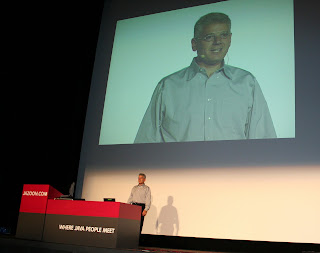On the second day of JAZOON ...
The opening sessionRethinking Enterprise by Ted Neward (Neward & Associates) was a great introduction to the day! He pointed out the things that I'm talking about to all my relatives and friends -
the education system sucks! The problem is that almost everything that we learn in school we forget. And this is just because of the system - we are presented with some theory and then we are tested on that theory using some problem statement, and after that - nobody cares.
One great statement I put down - "The problem and its solution are never apart". And this statement actually describes the problem above - at schools we are never forced to think beyond the theory which we just learned.
This was also a funny talk with some jokes about the "long-haired guy". This is a good one - Ted said (jokingly of course):
I know how to make copy-paste in PowerPoint, because I am an architect!
.
 Open Architecture by Roy T. Fielding (Day Software).
Open Architecture by Roy T. Fielding (Day Software). This was a little boring talk, but to say the least it was truly right talk. I mean all the things that Roy was talking about are valid I think - of how the open architecture matters for open source software, how the ecosystems work, etc.
Now I know what the
Conway's Law is.
Any organization that designs a system (defined broadly) will produce a design whose structure is a copy of the organization's communication structure.
And also after Roy's talk I would like to try what can
Apache Sling do.
Spring Framework 2.5 - Selected New Features, Juergen Hoeller (SpringSource). This was a neat overview of Spring's AOP and the new features that can be implemented with Java annotations. Basically I could read everything he talked about in the web, but it is quite nice to get it to know from "the source".
Then I attended the session called
Stacking the deck by integrating Spring beans and Seam components by Dan Allen (TetraTech, Inc.). The point was that we can use Spring in co-operation with Seam in order to wire up JSF pages to the underlying beans, and this avoid using the expression language (EL). The talk was quite interesting and very technical too. It seems to me that the sessions that are somehow related to JBoss are the most interesting ones @ JAZOON.
JSR-303: From a world of Constraints to Constrain the world by Emmanuel Bernard (JBoss). Again, the JBoss related topic was just the right session to choose. Emmanuel was talking about the beans validation (JSR-303) which can be implemented using Java annotations. He also pointed out that there should be a clear separation between bean validation and conversion (and I do agree on that).
I noticed that theres a huge trend for most of the topics - the Java annotations. Almost in every presentations the authors wanted to implement things using annotation-based configuration. Perhaps, this is the real hype of meta-programming in Java community.
An interesting type of presentations is the one where the author is presenting a deployed solution and talking about the problems he faced while implementing the system. At the talk called
Distributed client/server Java Persistence by Alexander Snaps (Axen/Alten Group) the author was presenting his solution for offline clients with centralized database. He also mentioned a new framework he implemented for this purpose -
Hölchoko (need to have a look on it).
And the last session I attended was
Cluster your POJOs with PojoCache by Bela Ban (JBoss). This was just perfect as always :).




